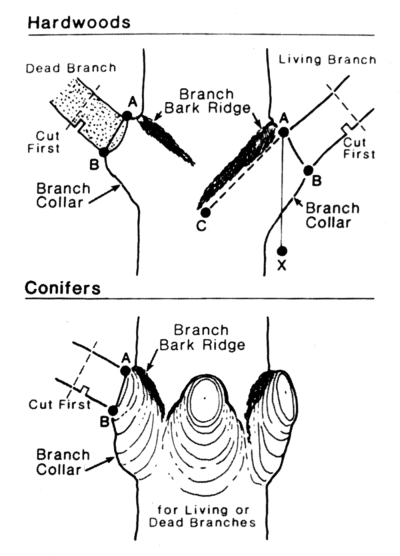Proper tree pruning is vital to a tree's survival
In order to prune trees, not only is some idea of tree function needed, but also a good understanding of the branch-trunk interaction zone.
The branch on a tree is an amazing structure. Trees with a branch collar system use good engineering principles to extend a cantilever from a vertical with no support brace underneath. Usually in the spring, as leaf growth is started, the cambial zone that covers the entire last growth ring under the bark will be activated to start forming a new growth ring. As this happens, new wood will be laid upon the existing growth ring from last year.

Diagram courtesy of Shigo Associates.
After the new branch wood is formed, the trunk wood is then laid down and wraps around the previously formed teardrop-shaped branch wood. The repeated layering of these two tissues through the years gives the branch its amazing strength and also clearly defines what is trunk structure and what is branch structure. As the trunk collar wraps around the branch collar, a distinctive ring is formed that is much larger than the branch. Literally, it is twice the diameter of the branch, since it contains the trunk collars also. This collar is where nature intended for the branch to be removed, and where most branches will abscise, or shed, on forest trees.
The branch base at the collar is one of the tree's strongest protection areas. In forests, most lower branches are removed through time by lack of light, decline, die-back, and shedding, the branch collar is naturally a place where fungus and pathogens can attack the large reserve of stored energy in the trunk. Research shows that when a branch is pruned properly, only the branch core or trace will be compartmentalized. Most of this is in “spring growth.” When the branch collar is injured and the natural protection zone destroyed, a tremendous amount of invasion can occur into the trunk and a much larger volume of living tissue will be compartmentalized.
When pruning, always stub cut your branches; that is, cut the end off your branch and leave a two- to three-inch stub. Be careful of bark tear-out on the bottom of the branch. Undercut the bottom first. Now you can concentrate on your target, the trunk branch collar. Look at the collar from both sides and project your imaginary pruning cut through the branch base against the collar. Be careful not to turn your saw in towards the trunk or the bottom of your cut will be too deep. If in doubt, go longer rather than shorted. Trees are much happier dealing with stubs than with flush cuts that remove the collar protection zone.
Dead branches will often have collar protection zones that extend outward. Look for the point just outside the original collar where there is a distinct diameter change in the branch. The branch protection zone has been extended and the tree will try to remove the branch at this point. Your cut should be just where the smaller diameter dead section of the branch meets the larger diameter extended protection zone. Feel for it; look for a line.
Never cover your pruning cuts with any substance. Research shows that nothing we have made will help the compartmentalization process.
The gist of this is that a working arborist today needs a 3D or X-ray approach to trees and their branches and roots. There are no extra leaves on trees; they all have important work to do. On a healthy tree, we can do some pruning to move ahead our own plans for the tree. a 10% reduction of leaf-bearing branches is a lot of pruning for one year. Wait another year, watch the tree's reaction to your work. Trees live a much slower, more evenly-paced life than we do.
On a sick tree affected by bacteria, e.g. fire blight (usually on a tree of the rosaceae family), only the deadwood and diseased area should be pruned.
The same goes for trees affected by fungi, for example, cytospora. Fungi can usually be dealt with where they are, at that spot, either by removal with a knife or by spraying them with a systemic fungicide (Benomyl).
Trees should never be topped. Plant the right sized tree in the right spot. Always remove deadwood. By doing so, compartmentalization is rapidly sped up.
Happy pruning! Hug your trees, and be sure to thank them for all their leaves that we pick up in the fall. As modern urban dwellers, we need as much cardiovascular exercise as we can get.
Kevin is indebted to the work of Dr. Alex Shigo in the preparation of this article.





















































































































